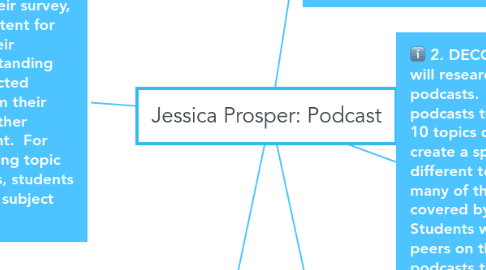Jessica Prosper: Podcast
by Jessica Prosper


1. 5. ABSTRACTION: After gathering data from their survey, students will select content for topics to discuss for their podcast. While understanding the content topics selected based on feedback from their peers, students can further expand on topic content. For example, if a high ranking topic was about video games, students could create derivative subject matter.
1.1. ABSTRACTION: abstraction – focusing on the important information only, ignoring irrelevant detail (BBC, 2018). Through abstraction, students can simplify complex data in order to manipulate it under different forms (Gretter & Yadav, 2016). By having students examine favored and not favored subject matter, will be beneficial in creating content that students will want to listen to. It also helps the podcast crew create worthwhile content for their intended audience.
1.2. Gretter, S., & Yadav, A. (2016). Computational thinking and media & information literacy: An integrated approach to teaching twenty-first century skills. New York: Springer US
1.2.1. CITATIONS
1.3. KS3 Computer Science - Introduction to computational thinking - Revision 1. (2018). Retrieved June 20, 2018, from https://www.bbc.com/education/guides/zp92mp3/revision/1
1.4. Google for Education. (n.d.). Computational Thinking for Educators - - Unit 1 - Introducing Computational Thinking. Retrieved June 20, 2018, from Computational Thinking for Educators - - Unit 1 - Introducing Computational Thinking
2. 4. ALGORITHMS: Students will create a survey of top topics for teen for podcasts. From gathering participant survey data, the podcast club will have a number of topics to start podcasting with. They will also understand the kinds of content teens like to listen to and create content from this data
2.1. ALGORITHMS RATIONALE: algorithms - developing a step-by-step solution to the problem, or the rules to follow to solve the problem (BBC, 2018). As students start to recognize subjects that teens are interested in, they can create their content for their podcast.
3. 1. PROBLEM: Students at CMS would like to start a podcast club. They are interested in finding out what students want to hear about in order to create podcasts. Students will research the most listened to podcast topics to create episodes for CMS.
3.1. Deliverables
4. 2. DECOMPOSITION: Students will research teen and kid podcasts. Students will search podcasts topics and tally the top 10 topics downloaded. They will create a spreadsheet with different topics and track how many of the same topics are covered by different podcasts. Students will then survey their peers on the top collected podcasts topics.
4.1. Decomposition Rationale: Decomposition is breaking down a complex problem or system into smaller, more manageable parts (BBC, 2018). Having students research top topics for kids their age and creating a spreadsheet will help in creating content for their podcast.
5. 3. PATTERN: As students collect data, the number of downloads per topics should start to create a pattern. The top downloaded topics for podcasts will be collected and students will create a digital survey for students as CMS to participate in based on the top 15 topics with the most downloads.
5.1. PATTERN RECOGNITION: Those same topics from different podcasts hosts should start to stand out from those topics with the least amount of downloads. Pattern Recognition: Observing patterns, trends, and regularities in data (Google for Education, n.d.)
5.1.1. Materials
5.1.2. Personnel
5.1.3. Services
5.1.4. Duration

